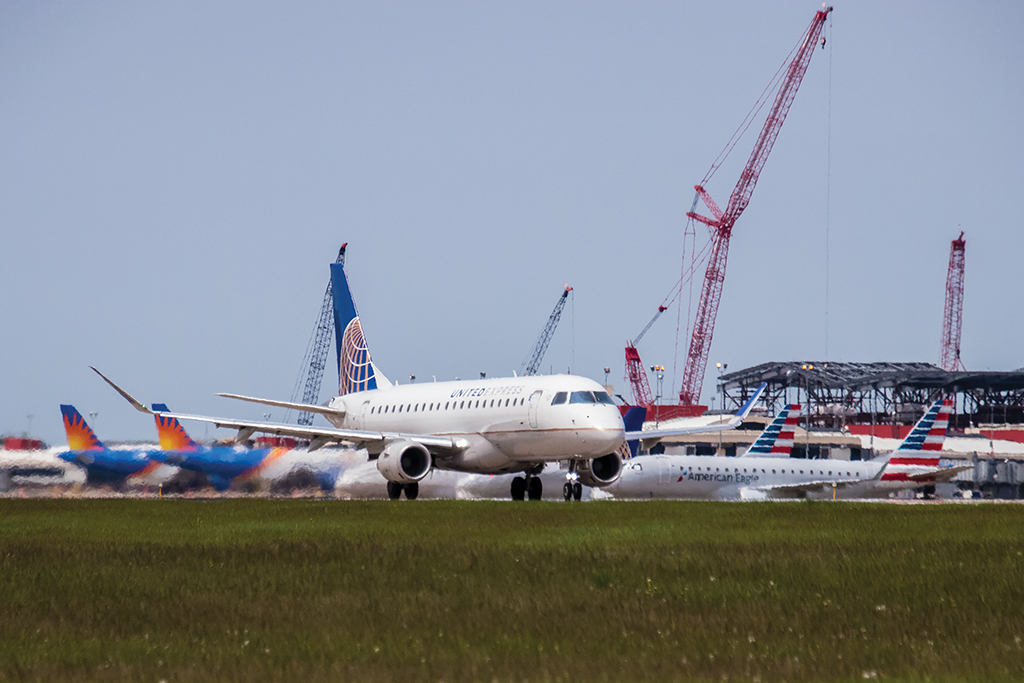
Melbourne Airport in Australia is constructing a second solar farm that, along with its first farm, will provide approximately 40% of the airport’s total energy needs.
Pittsburgh International Airport (PIT) has set the ball rolling on plans to become a producer of on-site sustainable aviation fuel (SAF). The initiative could see the airport not only supply SAF for use by its airline customers, but also ship it to other highly populated airport communities that lack space for their own production facilities.
“We have already established contracts with a couple of hydrogen production companies, leveraging our natural gas resources to facilitate hydrogen production,” said Christina Cassotis, CEO at Allegheny County Airport Authority, which oversees developments at the airport. “Our goal is to accelerate the adoption of cleaner and greener fuels and actively contribute to addressing the pressing global need within the aviation industry.”
A study undertaken by the US National Energy Technology Laboratory in 2021 found that it would be technically feasible to construct and operate a gas-to-liquids facility at PIT. It evaluated a 6,000-barrel-per-day facility that would produce nearly 70 million gallons of synthetic jet fuel per year, which could supplant about 85% of current jet fuel consumption at the Pennsylvania airport.

Cassotis told ATW that PIT already has empty tanks that US Airways left when it abandoned its hub almost two decades ago, as well as a pipeline to the Ohio River allowing for exports. The airport plans to take a “crawl, walk, run” approach to the production of SAF, starting first with plans to blend on site.
“As an airport, we see ourselves as having the opportunity to lead in this space and we have a lot of resources targeted towards that,” Cassotis said. “We feel we can be part of a solution that the industry really needs.”
The proposed SAF initiative comes two years after PIT became the world’s first airport to be fully powered by natural gas and solar energy. The airport’s utilization of natural gas wells and 9,360 solar panels across eight acres facilitated the creation of a microgrid that now serves as the primary energy source for the entire airport, including terminals and airfield facilities.
Solar Projects
While PIT may be in a unique position thanks to its natural gas wells, it is by no means alone when it comes to the production of on-site clean energy. Other airports, like Edmonton International Airport in Canada and Melbourne Airport in Australia, are also forging ahead with new solar farms to help them meet their net zero ambitions.
Edmonton is in the process of developing a 627-acre Airport City Solar project, which is anticipated to become the world’s largest solar farm at an airport. Once operational, it is projected to generate enough energy to power over 27,000 homes. Similarly, Melbourne is establishing a second solar farm that, along with its first farm, will provide approximately 40% of the airport’s total energy consumption needs.
Olivier Jankovec, director general at trade body ACI Europe, said an increasing number of airports worldwide are exploring ways to transform their business model to support the green energy transition. This shift is considered vital, not only to fulfill sustainability pledges, but also to diversify revenue sources beyond traditional traffic growth at a time when some governments are seeking to place limits on flying.
Jankovec emphasized that airports also have an opportunity to “redefine and enlarge” their societal relevance because the challenges posed by decarbonization are not solely confined to aviation but extend across the entire global economy.
One concept being explored by ACI is the idea of “enerports” that place airports as energy hubs. The massive land footprint of airport grounds allows for new on-site infrastructure that typically has not been associated with airport activity. This includes solar photovoltaic farms, blending facilities for liquid fuels, and storage for either liquid or gas hydrogen.
It is hoped that enerports will not only provide green energy to meet the needs of air connectivity, but also to meet the needs of nearby communities, contributing to carbon reduction efforts that extend beyond aviation.
“The local value of an airport has long been part and parcel of our nations and regions,” Jankovec said. “Now, we need to take this to the next level with the generation and supply of green energy for aviation and our surrounding communities alike.”
Airports of Tomorrow
To speed the development of enerports, ACI and the World Economic Forum (WEF) in June launched a project designed to address how airports can build, finance and house the infrastructure needed for the rollout of new technologies, such as hydrogen and electric propulsion, and SAF. The initiative, known as Airports of Tomorrow, brings together about 50 public and private stakeholders, including Arup, Bank of America, BP, HSBC, Neste and Shell.
“We’re aiming to bring all stakeholders—airports, airlines, OEMs, ground handling service providers, infrastructure and engineering companies, as well as financial institutions and policymakers—under one umbrella to address the challenges we jointly need to undertake as an ecosystem,” WEF industry decarbonization lead for aviation Laia Barbarà said.
She explained the initial focus seeks to anticipate future infrastructure needs at airports, enabling for the development of a “how to” framework outlining key steps for airports to take. In tandem with this, work is being done to explore how airports can further help to reduce third-party Scope 3 emissions and support the scale up of SAF production.
A key pillar will therefore concentrate on funding, with an objective to bring clarity as to what options are available for airports, as well as providing certainties to governments and investors. Airports of Tomorrow hopes to establish criteria that will streamline the evaluation process for banks and investors, making it easier for airports to secure the necessary finance for sustainability-linked developments.
“We need to invest $2.4 trillion in airports for the future—that is what is required to cope with the expected demand over the next 20 years,” ACI World director general Luis Felipe de Oliveira told ATW.
“However, when our members began competing for green finance, they found themselves being compared to other infrastructure projects. These projects ranged from shopping malls to road transport initiatives. By establishing applicable standards specifically for airports, we aim to assist our members in accessing green finance for the necessary investments required to sustain growth and meet future demand.”
De Oliveira said the framework being developed will provide a roadmap for airports to follow, ensuring that they meet the necessary requirements to qualify for green financing.
“Our goal is to develop a universally accepted standard that can be embraced by banks and investors, including pension funds,” he said.
Collaboration
Jonas Abrahamsson, CEO at Swedish airport operator Swedavia, said that such industry collaboration will be vital to ensure airports are able to play a wider role in society’s transition to clean energy.
“We are in the midst of the ecosystem of aviation and we can do a lot to influence, stimulate, and put incentives in place for the broader transformation,” he said.
Sweden has a goal of becoming the world’s first fossil-free country, reaching net zero emissions by 2045 at the latest. Swedavia, responsible for managing 10 airports in the country, including the Stockholm Arlanda hub, has already succeeded in attaining net zero emissions across all its facilities.
“In Sweden, we have the benefit of having close cooperation between industry and politics,” Abrahamsson said. “Each of the different industries that are part of the problem have been working for some time on their roadmap to become fossil free.”
Since 2020, when Swedavia achieved its goal of zero fossil carbon emissions in its own airport operations, the company has focused on helping to reduce emissions throughout the value chain. It participates in collaborations with external parties to promote the development of electric- and hydrogen-powered aircraft and has implemented an incentive program in which airlines can apply for subsidies for voluntarily refueling with SAF.
Although Swedavia estimates that the share of SAF used for refueling in 2022 was just 0.46%, the goal is 5% by 2025. Abrahamsson said that strong demand so far demonstrates that the market is there—and investment now needs to focus on the development of larger scale facilities.
“People stopped flying in Sweden because that was the only way to keep the sustainability flag up high,” he said, referring to the flight shaming movement that gained momentum across parts of Europe toward the end of the last decade. “We wanted to demonstrate that there are other ways you can do it. People can fly in renewable ways, which is better than stopping flying. If everybody’s doing something, it will swing the needle at some point in time.”
At London Heathrow (LHR), the airport has a £38 million ($48 million) fund to encourage airlines to use SAF, with the incentive aimed at covering up to 50% of the extra cost of SAF compared to conventional jet fuel. The oversubscribed scheme started in 2022 and aims to supply 1.5% of airlines’ fuel needs with SAF this year. Although the percentage is small, it makes LHR one of the world’s largest users of SAF, derived mainly from used cooking oil. A target of 11% has been set for 2030.
John Holland-Kaye, LHR’s outgoing CEO, agrees with Abrahamsson that greater investment is needed to scale up the production of SAF, and he called on airports to be “advocates for change,” saying they must demand more supportive government policies, so they not only have a license to grow, but a license to exist.





